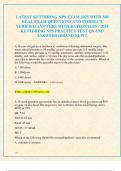LATEST KETTERING NPS EXAM 2025 WITH 300
REAL EXAM QUESTIONS AND CORRECT
VERIFIED ANSWERS WITH RATIONALES / 2024
KETTERING NPS PRACTICE TEST QS AND
ANSWERS (BRAND NEW!)
A 16-year old girl is on mechanical ventilation following abdominal surgery. Her
mean arterial pressure is 94 mmHg, central venous pressure is 4 mmHg, mean
pulmonary artery pressure is 15 mmHg, pulmonary capillary wedge pressure is 10
mmHg, and cardiac output is 5L/min. The physician asks the neonatal/pediatric
specialist to determine the vascular resistance of the systemic circulation. Which of
the following would the specialist report to the physician?
A. 1240 dynes
B. 1300dynes
C. 1440 dynes
D. 1600 dynes - ANSWER-C. 1440 dynes
SVR= ((MAP-CVP)/CO) x 80
A 32-week gestation age neonate has an umbilical artery blood gas drawn on 50%
oxygen via oxy-hood. His respiratory rate is 84/min, he has nasal flaring, and a
SPO2 of 74%.
pH: 7.24
PaCO2: 63 torr
PaO2: 45 torr
HCO3-: 27 mEq/L
BE: 1
Which of the following should the neonatal/pediatric specialist recommend?
A. continue to monitor
pg. 1
,B. Initiate nasal CPAP
C. intubate and initiate CPAP
D. intubate and initiate mechanical ventilation - ANSWER-D. intubate and initiate
mechanical ventilation
Six hours after delivery, a 26-week gestation age neonate is currently on
mechanical ventilation. Current settings are PC, SIMV, PIP 26 cm H2O, frequency
30/min, inspiratory time 0.5 sec, FiO2 60%, Peep 4 cmH2O. The patients PaCO2
is 50 torr and the PaO2 is 60 torr. What is the neonates a/A ratio?
A. 0.09
B. 0.13
C. 0.17
D. 0.21 - ANSWER-C. 0.17
PAO2= (FiO2*7)-(CO2+10)
a/A ratio= PaO2/PAO2
A sample is drawn from the umbilical artery catheter of a term infant on
mechanical ventilation. Current ventilator settings and blood gas results are:
Mode: PC,SIMV
PIP: 22 cm H2O
Rate: 24/min
Tinsp: 0.4 sec
FiO2: 40%
Peep: 3 cm H2O
pH: 7.35
PaCO2: 45 torr
PaO2: 40 torr
pg. 2
,HCO3-: 24 mEq/L
BE: 1
The neonatal/pediatric specialist should increase the
A. Rate
B. PIP
C. FiO2
D. PEEP - ANSWER-C. FiO2
The following spirometry results are obtained from a 12-year old boy:
FVC(L) Predicted 3.18 Observed 2.66 %-predicted: 84
FEV1(L) Predicted 2.38 Observed 1.68 %-predicted 71%
FEV1/FVC (%) Predicted 80 Observed 63
Which of the following should the neonatal/pediatric specialist recommend?
A. repeat the test
B. perform a post-bronchodilator study
C. measure thoracic gas volume
D. measure gas diffusing capacity - ANSWER-B. perform a post-bronchodilator
study
The neonatal/ pediatric specialist is preparing to extubate a 14- year old patient
who required mechanical ventilation because of a sever exacerbation of asthma.
The specialist has obtained the equipment necessary for the procedure. in what
sequence should the specialist perform the procedure?
A. suction the airway, deflate the cuff, encourage the patient to cough, remove the
tube during exhalation, observe the patient for complications, and administer
oxygen.
pg. 3
, B. suction the airway, deflate the cuff, remove the tube at peak inspiration,
encourage the patient to cough, administer oxygen, and observe the patient for
complications.
C. Deflate the cuff, suction the airway, remove the tube while suctioning,
encourage the patient to cough, administer oxygen, and observe the patient for
complications.
D. Deflate the cuff, suction the airway, remove the tube at peak inspiration,
encourage the patient to cough, and observe t - ANSWER-B. suction the airway,
deflate the cuff, remove the tube at peak inspiration, encourage the patient to
cough, administer oxygen, and observe the patient for complications.
An infant born to a mother who smoked cigarettes during pregnancy is at a greater
risk of
A. central nervous system dysfunction
B. intrauterine growth retardation
C. teratogenic effects
D. lower intellectual level - ANSWER-B. intrauterine growth retardation (also low
birth weight and preterm birth)
Central nervous system dysfunction: alcohol consumption
teratogenic effects: alcohol consumption
lower intellectual level: maternal malnutrition or diabetes
A 14-day old, 44 week gestation age neonate with meconium aspiration is being
mechanically ventilated. Currently, the infant requires a mean airway pressure of
20 cm H2O and 100% oxygen to maintain a PaO2 of 40 torr. Which of the
following should the neonatal/pediatric specialist recommend based on this
patients oxygen index (OI)?
A. Maintain current therapy
B. increase the minute ventilation
C. Perform the Raskind Procedure
pg. 4





